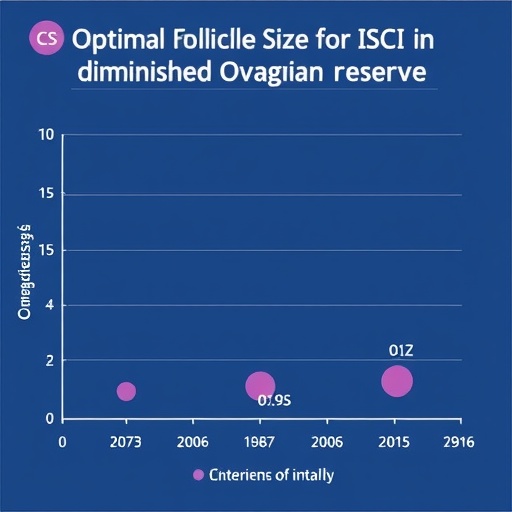In an era where reproductive technology has advanced significantly, the complexities surrounding fertility treatments continue to be a major topic of exploration. A recent study published in the Journal of Ovarian Research sheds light on an essential aspect of Intra-Cytoplasmic Sperm Injection (ICSI) cycles—specifically, the determination of optimal follicle size at the time of trigger in patients with diminished ovarian reserve. This research, led by Naghshineh and colleagues, presents crucial insights that could redefine treatment protocols and improve outcomes for a population often facing additional challenges in fertility.
Diminished ovarian reserve (DOR) is a condition characterized by a reduced capacity of the ovaries to produce eggs, which can significantly hinder fertility. For individuals experiencing this condition, the window for successful conception narrows, making the timing and approach of assisted reproductive technologies all the more critical. The study’s focus on follicle size is particularly relevant, as the size directly correlates with the maturity and viability of the oocytes (eggs), thus affecting the success rates of ICSI.
The researchers meticulously evaluated various follicle sizes at the point of triggering ovulation—an essential step in the ICSI procedure—while also considering the unique biological factors at play in patients with DOR. Through their investigation, they aimed to empirically establish the ideal follicle size that would maximize the chances of a successful outcome. This aspect of their study underscores the importance of precision in treatment protocols, especially for a demographic that is often underserved in reproductive research.
One of the pivotal findings of the study was the identification of a specific range of follicle sizes that correlated with higher fertilization rates and improved embryo quality. By systematically analyzing the data from a cohort of patients undergoing ICSI, the researchers were able to draw significant conclusions that advocate for tailored approaches in managing DOR cases. The implications of these findings are profound, as they not only contribute to the existing literature but also suggest practical adjustments to clinical practices.
Moreover, the work conducted by Naghshineh et al. emphasizes the need for continual research in this area, particularly considering that reproductive technologies are constantly evolving. The establishment of optimal follicle sizes for triggering ovulation could lead to enhanced protocols that optimize the timing of hCG administration, which is crucial for triggering follicle maturation. Given the complexities associated with DOR, such insights could profoundly enhance the effectiveness of ICSI cycles, providing hope to countless individuals and couples longing for parenthood.
The study also opened the door for future investigations into the underlying mechanisms that dictate follicle behavior in diminished ovarian reserve settings. What factors contribute to the developmental competence of larger versus smaller follicles? How do hormonal levels at the time of trigger interact with these follicle sizes? Deeper understanding of these relationships can provide broader insights into female reproductive health, paving the way for innovative treatment methodologies.
In addition to its immediate clinical applications, the findings of this research are likely to resonate in the broader context of fertility preservation strategies. For women diagnosed with conditions leading to diminished ovarian capacity, such as endometriosis or premature ovarian failure, understanding the dynamics of follicle development could prove invaluable. It opens up potential avenues for fertility preservation methods, which could be invaluable for those looking to safeguard their reproductive potential.
The relationship between egg quality and follicle size is not just a technical detail; it embodies the complexities and intricacies of human reproduction. With increasing numbers of people embarking on fertility treatments—many of whom are navigating the emotional and physical toll of DOR—research such as that conducted by Naghshineh and colleagues becomes crucial. Their contributions serve as a beacon of hope and knowledge, guiding both practitioners and patients through the challenging landscape of assisted reproductive technologies.
Additionally, as reproductive health advocacy continues to gain momentum, the significance of targeted studies that address the needs of specific populations cannot be overstated. Researchers and clinicians alike are called to engage actively with these findings, ensuring that they translate into tangible improvements in patient care. The call to action is clear: fertility specialists must adopt practices informed by the latest research innovations to provide the best outcomes for their patients.
In conclusion, the work surrounding optimal follicle size during ICSI cycles is only the tip of the iceberg when it comes to the vast array of research needed in the fertility domain, particularly for those facing challenges such as diminished ovarian reserve. Continuous investigation and collaborative efforts in this field are essential for developing frameworks that enhance patient outcomes. The journey toward understanding and overcoming the hurdles of infertility is ongoing, and with studies like these leading the way, there is a collective sense of optimism for the future of reproductive health.
This research not only deepens our understanding of the fertility landscape but also serves as a reminder that, in the realm of human reproduction, knowledge is power—an empowering force for patients and healthcare providers alike.
Subject of Research: Determination of optimal follicle size in ICSI cycles for patients with diminished ovarian reserve.
Article Title: Determination of the optimal follicle size at the time of trigger in patients with diminished ovarian reserve undergoing ICSI cycle.
Article References:
Naghshineh, E., Tehrani, H.G., Mehrabian, F. et al. Determination of the optimal follicle size at the time of trigger in patients with diminished ovarian reserve undergoing ICSI cycle.
J Ovarian Res 18, 284 (2025). https://doi.org/10.1186/s13048-025-01873-2
Image Credits: AI Generated
DOI: https://doi.org/10.1186/s13048-025-01873-2
Keywords: Diminished ovarian reserve, follicle size, ICSI cycles, reproductive health, egg quality.




